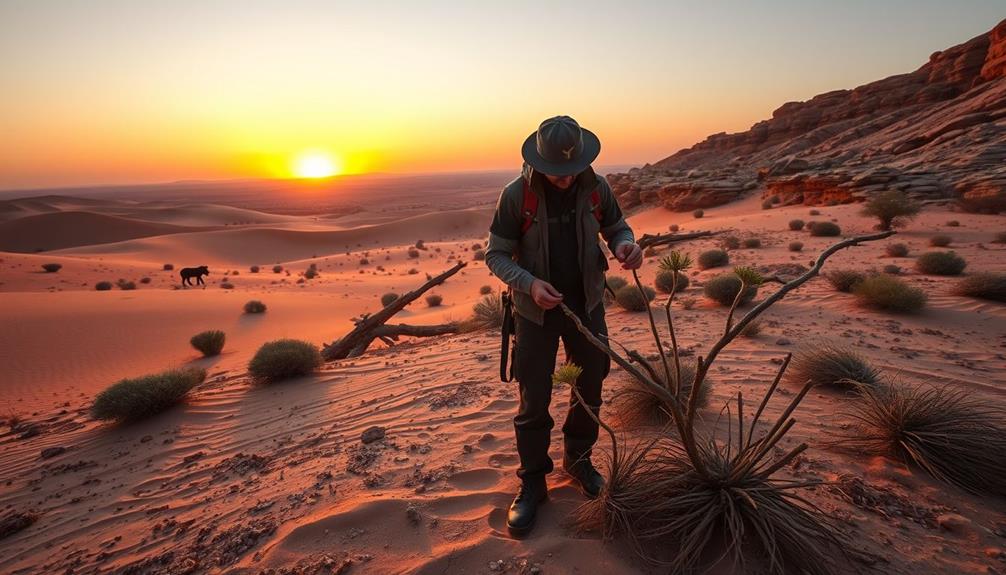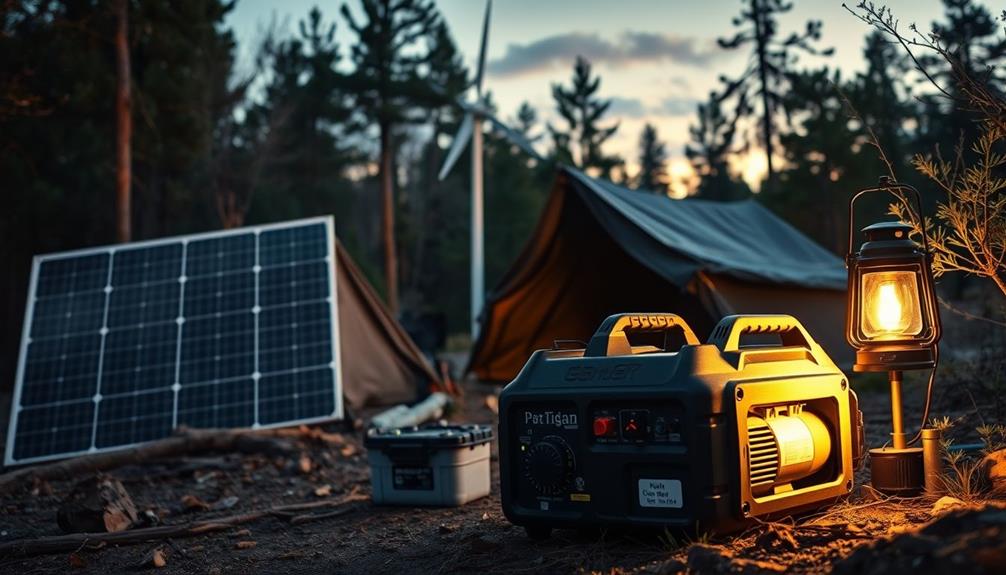To master desert survival, you need to forage wisely and hunt effectively. Start by sourcing water; look for moisture in cacti, collect dew, or dig in dry riverbeds. Identify edible plants like prickly pear and yucca, and always guarantee to positively identify them. When hunting, traps are often more effective than chasing after game, so set snares near water sources. Pay attention to the seasons—each provides unique food options. Remember to practice sustainable harvesting by leaving some plants intact. There's plenty more to discover that could enhance your survival skills in the desert.
Key Takeaways
- Identify edible plants like prickly pear, agave, and yucca to ensure a sustainable food source in the desert.
- Look for moisture signs, such as digging in dry riverbeds or collecting dew at dawn for hydration.
- Use trapping methods over hunting for better success in sparse environments, focusing on animal pathways.
- Practice sustainable harvesting by leaving enough plants intact and avoiding polluted areas for foraging.
- Adapt your efforts based on seasonal availability of food, such as fruits in summer and roots in winter.
Water Sourcing Strategies

When you find yourself in a desert survival situation, sourcing water becomes your top priority.
Start by looking for signs of moisture in the landscape. Certain plants, like cacti and succulents, can yield small amounts of water, especially during early morning when temperatures are cooler.
Digging in dry riverbeds may reveal underground water sources, but be cautious and check for any contaminants. If you have a container, consider collecting dew at dawn; it can provide a revitalizing hydration boost.
Additionally, if it rains, capture every drop by using makeshift containers or tarps.
Always remember, hydration is more critical than food, so prioritize your water intake and monitor your supply closely to guarantee your survival.
Identifying Edible Plants

In the harsh environment of the desert, knowing how to identify edible plants can be a game changer for your survival. Familiarizing yourself with the local flora not only boosts your chances of finding food but also provides essential hydration.
Here's what you should look for:
- Prickly Pear: Sweet, nutritious pads and fruits.
- Agave: Rich in sugars and fiber, perfect for energy.
- Yucca: Edible flowers and roots with a starchy texture.
- Mesquite: Provides natural sugars without sugar spikes.
- Cattails: Versatile and packed with nutrients; every part is useful.
Knowing these plants can mean the difference between hunger and nourishment, so get to know your surroundings and stay alert!
Safe Foraging Techniques

Foraging in the desert can be a rewarding experience, but safety should always come first. Start by positively identifying plants before consuming them; use botanical names and reputable guides to avoid mistakes.
When trying a new plant, taste a tiny amount first to verify you don't have an adverse reaction. Steer clear of areas near roads or polluted spots to avoid contaminated edibles.
Remember to practice sustainable harvesting; leave enough plants for future generations and use clean cuts with sharp tools. Rotate your foraging locations to allow plants to recover.
Hunting and Trapping Basics

Mastering hunting and trapping techniques can greatly boost your chances of survival in the desert. By understanding these methods, you can secure valuable protein sources while conserving energy.
Here are key concepts to keep in mind:
- Trapping often yields better results than hunting due to sparse animal populations.
- Set traps along animal pathways or near water sources for peak success.
- Use simple traps like snares or deadfalls made from natural materials.
- Guarantee humane treatment by checking traps frequently to minimize suffering.
- Always prioritize water availability, as increased protein intake demands more hydration.
Embrace these skills, and you'll enhance your survival experience in the harsh desert landscape.
Seasonal Food Insights

Understanding the seasonal availability of food in the desert can greatly enhance your survival strategy.
During spring, you'll find blooming cacti and tender greens, providing hydration and nutrients.
Summer brings fruits like prickly pear, which are both invigorating and rich in vitamins.
Fall is the time to gather seeds and nuts, such as acorns, while winter offers roots and tubers that can sustain you through colder months.
Pay attention to these seasonal patterns to optimize your foraging efforts. Knowing when to harvest not only improves your diet but also guarantees you respect the natural cycles of the ecosystem.
Stay adaptable, and remember that the desert's bounty changes with the seasons, so always be ready to shift your focus.
Cultural Significance of Foraging

The seasonal patterns of food availability in the desert not only influence survival strategies but also shape cultural practices and traditions. Foraging connects you to the land, creating a sense of belonging and respect for nature.
This connection is evident in rituals, storytelling, and communal gatherings centered around the harvest.
- Celebrating the harvest fosters community bonds.
- Sharing knowledge of edible plants honors ancestral wisdom.
- Collecting seasonal foods connects you to your heritage.
- Saguaro cactus fruit symbolizes resilience and sustenance.
- Foraging teaches appreciation for the delicate balance of ecosystems.
Sustainable Harvesting Practices

Embracing sustainable harvesting practices is essential for ensuring that desert ecosystems thrive while providing for your needs.
When foraging, always prioritize positive identification of plants and avoid contaminated areas. Use sustainable techniques by leaving enough of a plant's population intact, and make clean cuts with sharp tools to minimize damage.
Rotate your foraging spots to allow plants time to recover, ensuring future availability.
When hunting, focus on trapping, as it's often more effective in sparse environments. Set traps near water sources and paths, checking them frequently for humane treatment.
Educate yourself on local foraging laws and regulations to promote responsible practices.
Frequently Asked Questions
What Are the Signs of Dehydration in Desert Survival Situations?
In desert survival, you'll notice signs of dehydration like dry mouth, fatigue, dizziness, and dark urine. If you experience these symptoms, it's essential to find water immediately to avoid severe health risks.
How Can I Purify Water Sourced From Plants?
Imagine sipping nature's invigorating elixir; you can purify plant-sourced water by boiling it for at least one minute. Alternatively, filter through cloth or use chemical treatments to eliminate impurities and guarantee safe drinking.
What Tools Are Essential for Effective Foraging in the Desert?
For effective foraging in the desert, you'll need a reliable knife for cutting, a sturdy bag for collecting, a field guide for plant identification, and gloves to protect your hands from thorns and spines.
How Do I Safely Store Foraged Food for Later Use?
To safely store foraged food, you'll need clean containers, breathable bags, and cool, dark spaces. You'll dry, freeze, or can your finds, preserving nutrients while ensuring flavor and safety for future meals.
What Wildlife Should I Avoid When Hunting in the Desert?
When hunting in the desert, avoid venomous snakes, scorpions, and aggressive animals like coyotes and mountain lions. These species can pose serious risks to your safety and should be respected from a distance.
Conclusion
In the vast canvas of the desert, mastering survival skills transforms you from a mere wanderer into a resilient explorer. By honing your foraging and hunting techniques, you not only adapt to this challenging environment but also thrive within it. Remember, the desert offers both sustenance and lessons—listen closely, and you'll discover how to dance with its rhythms. Equip yourself with knowledge and a spirit of respect, and you'll conquer the arid wilderness with confidence. As day fades into night, the desert’s temperature plummets, reminding you of the importance of campfire survival techniques to stay warm and safe. Mastering the art of building and maintaining a proper campfire not only wards off the biting cold but also deters nocturnal predators. In this harsh land, every flame becomes a beacon of resilience, illuminating the path to survival.










